Insight: the future of Morgan (www.autocar.co.uk/)
Morgan designer Jon Wells has strong views about the firm’s future. We hears about his plan to evolve nostalgia – and some of his outlandish concepts
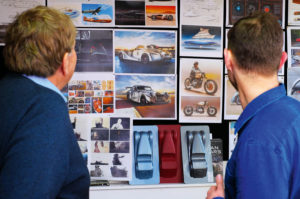
This time last year, Jon Wells, head of design at sports car company Morgan, hit the headlines for his design of a V8-engined chop-top special called Mog Rod, a Morgan-based hot rod that never was.
Always a prolific ideas man, he dashed it off in a few hours of spare time as part of a less than serious project for Mog Mag, the marque’s official organ. But the design proved such a hit on social media that one Morgan dealership found itself having to refuse a deposit from a customer desperate to buy this fantastic new model from Malvern Link.
Over time, and with the blessing of Morgan’s management, Wells penned a whole set of unlikely vehicles: a 4×4, a lakes racer, a tractor, an aeroplane, a sailing junk, a motorcycle and more, all utilising Morgan’s unique design cues. It was amusing for readers, but it also showed how freethinking today’s Morgan company has become. One wonders which other car company would allow its controller of future shapes to propose outlandish vehicles and put them on display for anyone to see.
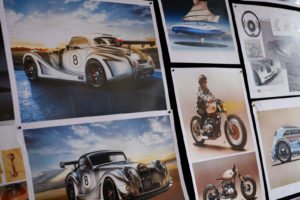
“Most of the designs were just fun,” says Wells, “and none of them will ever be built. But without identifying which ones, I can say a few have a hint of serious content – not the vehicle itself but a detail or a point of interest we might one day choose to take forward.”
More than that, however, the Mog Mag project showed how design conscious Morgan has become since it began hiring professional designers a dozen years ago and putting their output into production. In the old days, Malvern Link was known for three things: having a 10-year waiting list, always making the same cars and growing slowly older with its customers. Today, mercifully, none of these things is true; the company has the capacity it needs to meet demand, and its cars have embraced new technology so that they appeal to young as well as old.
Surely, I suggest to Wells, the century-old traditions of Morgan must remain a big constraint for anyone seeking to shape the models of the future, mustn’t they? But he argues the other way. “They bring us freedom,” he insists. “Aesthetic design is still relatively new to Morgan. It’s only about a decade since professionals started to change the way the cars look. And now we’ve reached the stage where we can start to evolve the company.”
This is the big issue I’ve been hoping to get to: how can Morgan evolve? Wells acknowledges a stuttering start for past new-era proposals (without actually fingering the controversially cross-eyed Aero 8 of the 2000 Geneva motor show, or the promising but stillborn LIFEcar and EvaGT projects on which he worked in his early Morgan days). Instead, he cites the arrival of new management and new marketing manpower as having brought much more clarity about the future. His own design group, based outside Morgan’s main clump of venerable buildings in “a little shed that leaks”, has lately doubled in size to four.
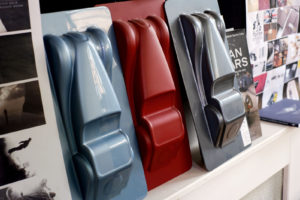
“We’ve proved we can do technology,” says Wells, “what with our electric powertrains and our Superformed alloy panels and our modern lightweight construction. But I don’t believe our cars should simply become modern, although we did explore that in the recent past. It was fun trying to distill Morgan qualities into a modern car, but we don’t believe that’s the right direction.
“Our business model is based on nostalgia,” he explains. “The look of our cars in the past has been related to influences of the 1940s and ’50s. As time passes, that will become the 1950s and ’60s – and later – and then you’re into beautiful, clean forms with a lot more aerodynamic considerations.
Dare we look at perfect cars of this era, like the Ferrari 250 short wheelbase? In a sense, it’s a shame those cars can’t still exist and be recreated now.
“I’m not suggesting we’d ever copy someone else’s iconic design. We don’t need to. We have coupés of our own, like that one [he indicates the company’s treasured Plus 4 Plus], to help us. And we won’t be constrained by purist classic forms, either. Their job is to inspire, not dictate. We’ll walk the line between old and new, as we’ve started to do with the EV3 electric three-wheeler.
“But I do believe future Morgans have a wonderful opportunity to become beautiful as they move forward. They should be all about proportions and perfectly executed detail, and that’ll make them unique.”
Wells cites two “very exciting” stand-alone products his designers are currently working up that will put all these principles into practice. “They’re both huge projects,” he says. “One is extra-special, from the aesthetic point of view.” The previous coupé conversation, and the obvious relish Wells puts into absent-mindedly drawing a rakish coupé as we talk (he also sketches in board meetings), makes me wonder if at least one of these new cars is going to be a large, low, classically styled fixed-head two-seater…
Wells arrived at Morgan full time about nine years ago, having done work experience at Morgan and TVR while studying for a degree in vehicle design at Huddersfield University, where he topped the course. He was hired in 2007 by his predecessor, Matt Humphries, who had arrived at Morgan from Coventry University three years earlier, having impressed then-managing director Charles Morgan with his student proposals for the Aero 8.
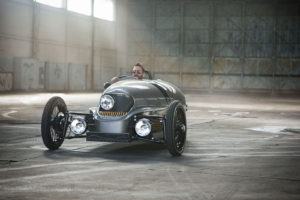
“My first job here was a six-week secondment that turned into five months’ work,” says Wells. “I worked on the first Morgan pedal car, a really cool project for a student because it was a full design job, built on a wooden frame with a panel-beaten body. The company eventually sold 250 of them, at £2500 each. Then I went back to college for my last year – and got the call from Matt to come back in 2008. I did bits and pieces, worked on the production Aeromax and the Aero Supersports and it gradually turned into a job. I never signed anything – and I still haven’t.”
Wells, whose grandfather designed key electrical components for Concorde, is the closest thing you’ll ever meet to a design ‘natural’. Like many kids, his early interest was in bicycles and motorbikes, which he drew non-stop. But he soon fell in love with the car design process, particularly the way clay and computer modelling could make sense of your ideas. “Sketches are just lines,” he says. “I found clay and computer modelling could convey much better what was in my head.”
Spend an afternoon with Wells, as I did, and you’ll be amazed at the sheer breadth of his work. Small wonder he feels he doesn’t get enough time for sketching. He talks marketing and customer relations. His team designs brochures, letterheads, logos, show stands, car badges and whatever else needs designing – as well as the cars. He acknowledges the versatility but denies it is anything special at Malvern Link.
“Morgan requires this of everyone,” he says. “So many of the people here are incredibly talented. It’s one of the reasons I love working here. I’ll have an idea for a dashboard or a piece of leatherwork, but it’s not until I’ve shown it to the guys who’ll actually make it that it comes to life. I’m not just saying this; they have as much design input as I do.”
FIVE FANTASY MORGANS
Just for fun, Jon Wells has created a series of vehicles that Morgan would never build, using the firm’s timeless design cues. Here are some highlights.
2-2 MOTORBIKE
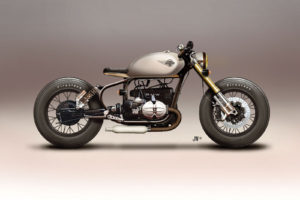
“This one’s my favourite. I’ve used classic BMW bits, but it’s very spare, with a hand-beaten tank, a wooden surround for the tank and seat and lots of brass detailing.”
PLUS OAR
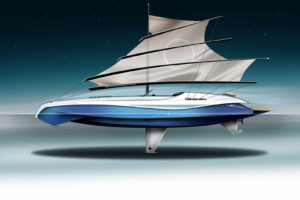
“Here’s one we probably won’t be doing. It sails — note the junk rig — but can also go 20 knots with the help of a 3 Wheeler engine. Cockpit is reminiscent of a Morgan classic.”
AERO 8 GT3
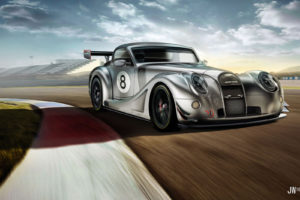
“I give this one 10 out of 10 for Mog factor. We’ve built cars like this before and it fits the company’s ethos very well. I especially like the GT3 detailing of this one.”
MOG ROD
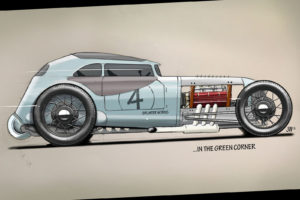
“This was great fun. Having a car like this is an ambition of mine. It also allowed me to involve the fourseater, the only time the Classic Morgan profile has been changed.”
AERO AV8
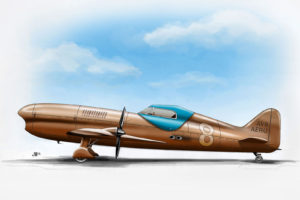
“When you sketch something, you never know how it’ll turn out, but I really like the hooded fighter cockpit of this one, which I have to admit is a bit out of our usual line.”
